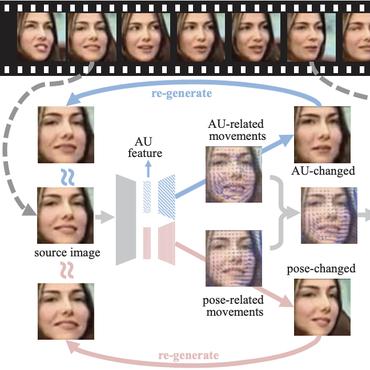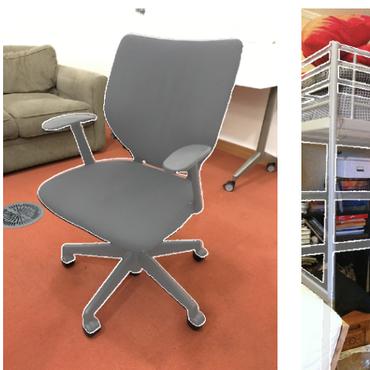Search Results for author: Qingyong Hu
Found 26 papers, 21 papers with code
GPT as Psychologist? Preliminary Evaluations for GPT-4V on Visual Affective Computing
2 code implementations • 9 Mar 2024 • Hao Lu, Xuesong Niu, Jiyao Wang, Yin Wang, Qingyong Hu, Jiaqi Tang, Yuting Zhang, Kaishen Yuan, Bin Huang, Zitong Yu, Dengbo He, Shuiguang Deng, Hao Chen, Yingcong Chen, Shiguang Shan
In conclusion, this paper provides valuable insights into the potential applications and challenges of MLLMs in human-centric computing.
FedGT: Federated Node Classification with Scalable Graph Transformer
no code implementations • 26 Jan 2024 • Zaixi Zhang, Qingyong Hu, Yang Yu, Weibo Gao, Qi Liu
However, existing methods have the following limitations: (1) The links between local subgraphs are missing in subgraph federated learning.
MC-Stereo: Multi-peak Lookup and Cascade Search Range for Stereo Matching
1 code implementation • 4 Nov 2023 • Miaojie Feng, Junda Cheng, Hao Jia, Longliang Liu, Gangwei Xu, Qingyong Hu, Xin Yang
This architecture mitigates the multi-peak distribution problem in matching through the multi-peak lookup strategy, and integrates the coarse-to-fine concept into the iterative framework via the cascade search range.
PVP: Pre-trained Visual Parameter-Efficient Tuning
no code implementations • 26 Apr 2023 • Zhao Song, Ke Yang, Naiyang Guan, Junjie Zhu, Peng Qiao, Qingyong Hu
Large-scale pre-trained transformers have demonstrated remarkable success in various computer vision tasks.
 Ranked #4 on
Image Classification
on VTAB-1k
(using extra training data)
Ranked #4 on
Image Classification
on VTAB-1k
(using extra training data)
Small but Mighty: Enhancing 3D Point Clouds Semantic Segmentation with U-Next Framework
1 code implementation • 3 Apr 2023 • Ziyin Zeng, Qingyong Hu, Zhong Xie, Jian Zhou, Yongyang Xu
While the fundamental framework of point cloud semantic segmentation has been largely overlooked, with most existing approaches rely on the U-Net architecture by default.
Backdoor Defense via Deconfounded Representation Learning
1 code implementation • CVPR 2023 • Zaixi Zhang, Qi Liu, Zhicai Wang, Zepu Lu, Qingyong Hu
The other clean model dedicates to capturing the desired causal effects by minimizing the mutual information with the confounding representations from the backdoored model and employing a sample-wise re-weighting scheme.
BUFFER: Balancing Accuracy, Efficiency, and Generalizability in Point Cloud Registration
1 code implementation • CVPR 2023 • Sheng Ao, Qingyong Hu, Hanyun Wang, Kai Xu, Yulan Guo
Extensive experiments on real-world scenarios demonstrate that our method achieves the best of both worlds in accuracy, efficiency, and generalization.
Hierarchical Graph Transformer with Adaptive Node Sampling
1 code implementation • 8 Oct 2022 • Zaixi Zhang, Qi Liu, Qingyong Hu, Chee-Kong Lee
The Transformer architecture has achieved remarkable success in a number of domains including natural language processing and computer vision.
DevNet: Self-supervised Monocular Depth Learning via Density Volume Construction
1 code implementation • 14 Sep 2022 • Kaichen Zhou, Lanqing Hong, Changhao Chen, Hang Xu, Chaoqiang Ye, Qingyong Hu, Zhenguo Li
Self-supervised depth learning from monocular images normally relies on the 2D pixel-wise photometric relation between temporally adjacent image frames.
4DAC: Learning Attribute Compression for Dynamic Point Clouds
no code implementations • 25 Apr 2022 • Guangchi Fang, Qingyong Hu, Yiling Xu, Yulan Guo
In addition, we also propose a deep conditional entropy model to estimate the probability distribution of the transformed coefficients, by incorporating temporal context from consecutive point clouds and the motion estimation/compensation modules.
Meta-Sampler: Almost-Universal yet Task-Oriented Sampling for Point Clouds
1 code implementation • 30 Mar 2022 • Ta-Ying Cheng, Qingyong Hu, Qian Xie, Niki Trigoni, Andrew Markham
In this work, we propose an almost-universal sampler, in our quest for a sampler that can learn to preserve the most useful points for a particular task, yet be inexpensive to adapt to different tasks, models, or datasets.
No Pain, Big Gain: Classify Dynamic Point Cloud Sequences with Static Models by Fitting Feature-level Space-time Surfaces
1 code implementation • CVPR 2022 • Jia-Xing Zhong, Kaichen Zhou, Qingyong Hu, Bing Wang, Niki Trigoni, Andrew Markham
Scene flow is a powerful tool for capturing the motion field of 3D point clouds.
 Ranked #1 on
3D Action Recognition
on NTU RGB+D
Ranked #1 on
3D Action Recognition
on NTU RGB+D
Not All Points Are Equal: Learning Highly Efficient Point-based Detectors for 3D LiDAR Point Clouds
1 code implementation • CVPR 2022 • Yifan Zhang, Qingyong Hu, Guoquan Xu, Yanxin Ma, Jianwei Wan, Yulan Guo
To reduce the memory and computational cost, existing point-based pipelines usually adopt task-agnostic random sampling or farthest point sampling to progressively downsample input point clouds, despite the fact that not all points are equally important to the task of object detection.
STPLS3D: A Large-Scale Synthetic and Real Aerial Photogrammetry 3D Point Cloud Dataset
4 code implementations • 17 Mar 2022 • Meida Chen, Qingyong Hu, Zifan Yu, Hugues Thomas, Andrew Feng, Yu Hou, Kyle McCullough, Fengbo Ren, Lucio Soibelman
Specifically, we introduce a synthetic aerial photogrammetry point clouds generation pipeline that takes full advantage of open geospatial data sources and off-the-shelf commercial packages.
3DAC: Learning Attribute Compression for Point Clouds
1 code implementation • CVPR 2022 • Guangchi Fang, Qingyong Hu, Hanyun Wang, Yiling Xu, Yulan Guo
Finally, the estimated probabilities are used to further compress these transform coefficients to a final attributes bitstream.
SensatUrban: Learning Semantics from Urban-Scale Photogrammetric Point Clouds
no code implementations • 12 Jan 2022 • Qingyong Hu, Bo Yang, Sheikh Khalid, Wen Xiao, Niki Trigoni, Andrew Markham
Each point in the dataset has been labelled with fine-grained semantic annotations, resulting in a dataset that is three times the size of the previous existing largest photogrammetric point cloud dataset.
Box2Seg: Learning Semantics of 3D Point Clouds with Box-Level Supervision
no code implementations • 9 Jan 2022 • Yan Liu, Qingyong Hu, Yinjie Lei, Kai Xu, Jonathan Li, Yulan Guo
In this paper, we introduce a neural architecture, termed Box2Seg, to learn point-level semantics of 3D point clouds with bounding box-level supervision.
Detecting and Tracking Small and Dense Moving Objects in Satellite Videos: A Benchmark
1 code implementation • 25 Nov 2021 • Qian Yin, Qingyong Hu, Hao liu, Feng Zhang, Yingqian Wang, Zaiping Lin, Wei An, Yulan Guo
Satellite video cameras can provide continuous observation for a large-scale area, which is important for many remote sensing applications.
Learning Semantic Segmentation of Large-Scale Point Clouds with Random Sampling
1 code implementation • 6 Jul 2021 • Qingyong Hu, Bo Yang, Linhai Xie, Stefano Rosa, Yulan Guo, Zhihua Wang, Niki Trigoni, Andrew Markham
We study the problem of efficient semantic segmentation of large-scale 3D point clouds.
SQN: Weakly-Supervised Semantic Segmentation of Large-Scale 3D Point Clouds
2 code implementations • 11 Apr 2021 • Qingyong Hu, Bo Yang, Guangchi Fang, Yulan Guo, Ales Leonardis, Niki Trigoni, Andrew Markham
Labelling point clouds fully is highly time-consuming and costly.
SpinNet: Learning a General Surface Descriptor for 3D Point Cloud Registration
1 code implementation • CVPR 2021 • Sheng Ao, Qingyong Hu, Bo Yang, Andrew Markham, Yulan Guo
Extracting robust and general 3D local features is key to downstream tasks such as point cloud registration and reconstruction.
 Ranked #2 on
Point Cloud Registration
on ETH (trained on 3DMatch)
Ranked #2 on
Point Cloud Registration
on ETH (trained on 3DMatch)
Towards Semantic Segmentation of Urban-Scale 3D Point Clouds: A Dataset, Benchmarks and Challenges
2 code implementations • CVPR 2021 • Qingyong Hu, Bo Yang, Sheikh Khalid, Wen Xiao, Niki Trigoni, Andrew Markham
An essential prerequisite for unleashing the potential of supervised deep learning algorithms in the area of 3D scene understanding is the availability of large-scale and richly annotated datasets.
Axiom-based Grad-CAM: Towards Accurate Visualization and Explanation of CNNs
3 code implementations • 5 Aug 2020 • Ruigang Fu, Qingyong Hu, Xiaohu Dong, Yulan Guo, Yinghui Gao, Biao Li
To have a better understanding and usage of Convolution Neural Networks (CNNs), the visualization and interpretation of CNNs has attracted increasing attention in recent years.
Deep Learning for 3D Point Clouds: A Survey
3 code implementations • 27 Dec 2019 • Yulan Guo, Hanyun Wang, Qingyong Hu, Hao liu, Li Liu, Mohammed Bennamoun
To stimulate future research, this paper presents a comprehensive review of recent progress in deep learning methods for point clouds.
RandLA-Net: Efficient Semantic Segmentation of Large-Scale Point Clouds
6 code implementations • CVPR 2020 • Qingyong Hu, Bo Yang, Linhai Xie, Stefano Rosa, Yulan Guo, Zhihua Wang, Niki Trigoni, Andrew Markham
We study the problem of efficient semantic segmentation for large-scale 3D point clouds.
 Ranked #3 on
Semantic Segmentation
on Toronto-3D L002
Ranked #3 on
Semantic Segmentation
on Toronto-3D L002
Learning Object Bounding Boxes for 3D Instance Segmentation on Point Clouds
1 code implementation • NeurIPS 2019 • Bo Yang, Jianan Wang, Ronald Clark, Qingyong Hu, Sen Wang, Andrew Markham, Niki Trigoni
The framework directly regresses 3D bounding boxes for all instances in a point cloud, while simultaneously predicting a point-level mask for each instance.
 Ranked #13 on
3D Instance Segmentation
on S3DIS
(mPrec metric)
Ranked #13 on
3D Instance Segmentation
on S3DIS
(mPrec metric)














